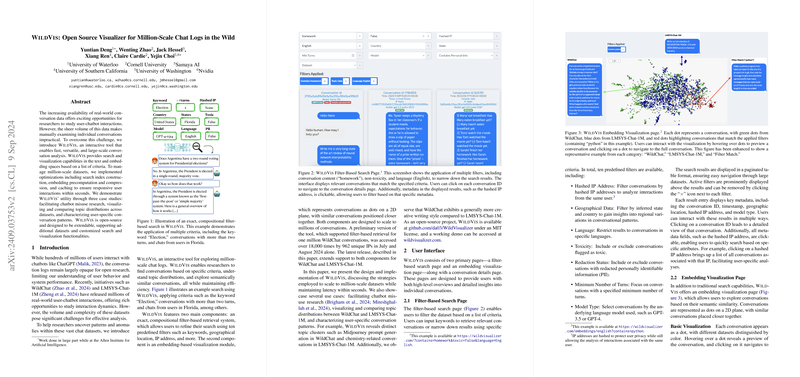Analysis of WildVis: An Open Source Visualizer for Large-Scale Chat Logs
The paper "WildVis: Open Source Visualizer for Million-Scale Chat Logs in the Wild" explores the development and functionalities of WildVis, a tool designed to handle large-scale conversational datasets consisting of user-chatbot interactions. This research addresses a critical gap in the accessibility and analysis of extensive chat logs by providing a specialized, interactive platform that enables researchers to efficiently sift through millions of data points to derive meaningful insights.
Scope and Contributions
WildVis is specifically architected to facilitate large-scale analysis of chat data, offering both search and visualization capabilities through a dual-component system. The first component is a filter-based search tool that allows for nuanced data retrieval via ten predefined filters—ranging from language and geographical metadata to toxicity and conversation length criteria. This reduces the complexity associated with large datasets by enabling more focused queries. The second component involves an embedding-based visualization module, which situates conversational data points in a 2D space to reveal semantic similarities and trends across the dataset.
The system's capacity to handle data at the million-scale is notable. It achieves this via optimizations such as the construction of search indices, precomputation and compression of conversation embeddings, and thorough caching mechanisms, all contributing to a latency of mere seconds for user interactions. This efficiency is critical when dealing with high-dimensional data, where computational load can otherwise be prohibitive.
Case Studies and Practical Implications
The paper elucidates three primary use cases illustrating the utility of WildVis:
- Chatbot Misuse Research: The tool facilitates research into instances of chatbot misuse by enabling easy retrieval and visualization of conversations that align with misuse phenotypes, such as unveiling attempts to leverage chatbots for journalism paraphrasing or illegal activities.
- Topic Visualization and Dataset Comparison: WildVis’ embedding visualization reveals distinct thematic clusters within datasets, such as writing assistance and coding queries, and allows the comparison of thematic distributions across datasets like WildChat and LMSYS-Chat-1M. This feature is highly beneficial for monitoring changes in user behavior over time or between different chatbot models.
- User-Specific Patterns Analysis: By aggregating a user's complete interaction history, researchers can identify patterns and dominant themes in individual behavior, which is crucial for personalizing dialogues in AI systems or understanding privacy implications.
Theoretical Implications and Future Directions
From a theoretical standpoint, WildVis underscores the importance of scalable, efficient tools to paper interaction dynamics in human-AI communication. By making massive real-world conversational data more accessible, the tool not only aids researchers in validating theoretical models of user interaction but also drives new hypotheses concerning user adaptation to conversational AI and the influence of sociolinguistic variables.
Speculatively, as AI continues to evolve, tools like WildVis could play a critical role in fine-tuning conversational agents, enhancing their adaptability to diverse interaction styles and cultural nuances by providing data-driven insights. Future iterations of WildVis might also incorporate deeper machine learning techniques for automatic anomaly and pattern detection, thereby automating parts of the data analysis process.
Conclusion
The WildVis tool presents a substantial step forward in the analysis of large-scale chat datasets, providing both practical utilities and foundational frameworks for future research in conversational AI analytics. Its open-source nature and extendability underscore its potential as a communal resource, which could be iteratively improved in collaboration with the research community to accommodate growing data sizes and evolving analytical needs.
